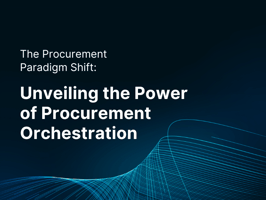In the dynamic world of procurement, a groundbreaking concept is gaining momentum – procurement...
Orchestration in Pharma R&D: A Unified Platform for Spend Management

Pharmaceutical and biotechnology R&D organizations are navigating unprecedented complexity, with teams managing hundreds of concurrent studies, coordinating global supplier networks, and processing thousands of transactions monthly, all while balancing stringent regulatory requirements and facing mounting cost pressures. The challenge extends across both direct spend (APIs, raw materials, clinical supplies) and indirect spend (CROs, consulting services, lab equipment, trial participants). Yet, many procurement approaches treat these as entirely separate domains.
This fragmentation creates blind spots, compliance risks, and missed opportunities for efficiency and cost savings. Scientists and researchers initiating the majority of R&D purchases are not procurement professionals or experts in navigating procurement tools and processes. Lack of knowledge or expertise about the appropriate system to use, which suppliers are preferred, or which approval workflows apply, results in frequent errors and delays. In some cases, where procurement processes are particularly complex or opaque, users bypass them entirely, leading to maverick spending, supplier proliferation, and costly compliance violations.
Leading R&D teams are now embracing orchestration as the solution: a unified, AI-powered platform that brings together intake, supplier management, and end-to-end transaction visibility across all spend categories, creating a seamless experience easily navigable by any user.
The Challenge: Complexity Across Both Spend Categories
Direct Spend Complexity. Direct procurement in the pharmaceutical industry involves sourcing of APIs, excipients, raw materials, and clinical supplies that directly impact product quality. These purchases require deep supplier relationships, rigorous quality validation, and precise regulatory documentation. Typically operating in a centralized function, direct procurement teams function within established processes and with systems expertise.
Indirect Spend Chaos. Indirect procurement, encompassing everything supporting R&D operations from CRO partnerships, clinical trial site payments, consulting services, lab equipment, and IT services, faces a more challenging procurement environment. Despite representing a significant portion of total procurement spend in many pharmaceutical organizations, indirect procurement is most frequently decentralized, inconsistent, and managed by non-procurement staff that lack familiarity with formal purchasing processes.
The User Experience Gap. The fundamental challenge is that the executives initiating purchases, particularly in R&D, are scientists and clinicians focused on advancing research and therapeutic development, not navigating procurement technology, managing supplier relationships, or implementing spend controls. When faced with multiple systems, unclear approval paths, or complex supplier onboarding requirements, they take alternative routes to purchasing, resulting in fragmented data, supplier sprawl, lost negotiating leverage, compliance gaps, and delayed cycle times precisely when spend and agility matter the most.
Traditional Approaches are Falling Short
Many organizations have attempted to solve these challenges with:
- Separate systems for direct and indirect procurement, creating data silos, and forcing users to know which tool to use for different purchases
- Complex approval matrices that slow decisions and frustrate requestors and suppliers
- Manual coordination via spreadsheets and email chains that lack visibility and audit trails
- Rigid workflows that do not adapt to the dynamic nature of R&D partnerships
These approaches may be suitable for procurement professionals but fail to meet the needs of the broader user base. Without an intuitive, unified experience, adoption remains low and value remains unrealized.
Orchestration: The End-to-End Solution
Procurement orchestration platforms like ORO solve these challenges by unifying the entire procurement lifecycle into a single, intelligent system that works for everyone, regardless of procurement expertise.
A Single Front Door for All Requestors. Rather than forcing users to navigate multiple systems or understand procurement taxonomy, orchestration provides one intuitive entry point. Whether a researcher needs to onboard a new CRO, order lab supplies, engage a consultant, or source a critical API, they simply describe what is required, and AI-powered intent detection understands the request type and automatically routes the purchase to the appropriate workflow, eliminating confusion and training requirements.
AI Guided Buying Journey. Modern orchestration leverages agentic AI to create an effortless experience, asking only for information that the requester has, auto-filling fields from existing systems, recommending preferred suppliers based on past performance and compliance status, and validating data in real time. Users receive intelligent guidance at every step, ensuring exactness and compliance without manual intervention or specialized knowledge.
Unified Supplier Management. All suppliers, whether providing APIs or consulting services, flow through consistent onboarding, risk assessment, and performance monitoring processes. The platform orchestrates collaboration across procurement, legal, finance, quality, and compliance teams, automating validation checks, triggering appropriate reviews based on spend thresholds or risk profiles, and maintaining complete audit trails. This eliminates supplier data fragmentation and ensures every vendor relationship meets regulatory and corporate standards.
Real-Time Visibility and Control. Orchestration consolidates data from every transaction, approval, and supplier interaction into a unified view, enabling procurement leaders to gain real-time insights into total spend patterns, bottlenecks, supplier performance, and compliance status across both direct and indirect categories. This visibility enables data-driven decision making, proactive risk management, and continuous process optimization.
Adaptive Workflows Without IT Dependencies. Pharma R&D operates in a constantly evolving environment where regulatory requirements, therapeutic strategies, and supplier landscapes shift rapidly. Orchestration platforms built on no-code architecture empower procurement teams to adapt workflows, update approval logic, and modify compliance checks in response to changing business needs without requiring developer resources or lengthy implementation cycles.
The Outcome: Agility, Compliance, and Value Across All Spend
With procurement orchestration, pharmaceutical R&D organizations achieve:
- Universal Adoption and Compliance. When the experience is intuitive and guided by AI, users naturally follow compliant workflows and paths. There is no need for extensive training documentation or constant enforcement mechanisms; instead, the platform automatically ensures the right approvals, suppliers, and controls are applied, dramatically reducing maverick spend and policy violations.
- Accelerated Cycle Times. Automated routing, intelligent validations, and self-service status visibility eliminate delays caused by manual handoffs and information requests. Teams can onboard suppliers in days rather than weeks, process requisitions in hours rather than days, and adapt to changing study needs at unprecedented speed.
- Holistic Spend Optimization. By uniting direct and indirect data, organizations gain leverage in supplier negotiations, identify consolidation opportunities across categories, detect spending anomalies and leakage, and allocate budgets with complete visibility into commitments and trends.
- Risk Mitigation and Regulatory Readiness. Orchestration creates comprehensive audit trails, enforces compliance checks at every step, consolidates risk scoring across multiple data sources, and provides real-time monitoring for supplier performance and regulatory changes. This is particularly critical in pharma, where supplier quality issues or compliance failures can have catastrophic consequences.
- Strategic Capacity for Procurement Teams. Automating routine task coordination and enabling self-service for end users, orchestration frees procurement professionals to focus on strategic initiatives such as supplier relationship development, category strategy, innovation partnerships, and value engineering.
Orchestration as Strategic Infrastructure
Unlike point solutions that address narrow procurement challenges or legacy systems that require extensive customization and training, orchestration platforms serve as the connective tissue across the entire procurement ecosystem. They don’t replace existing ERP, sourcing, or contract management systems. Instead, they integrate with and enhance these tools, creating a unified experience layer that makes complexity invisible to end users while providing procurement teams with unprecedented control and insight.
For pharmaceutical R&D organizations managing diverse, high-stakes spending across global operations, orchestration represents a fundamental shift from fragmented, process-heavy procurement to seamless, intelligent, and agile operations. It’s the platform that ensures every dollar, whether direct or indirect, is spent with purpose, visibility, and precision.
Want to learn more? Download our white paper, Reimagining Procurement for Pharma and MedTech Companies, now.




